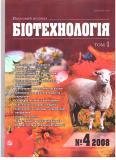ISSN 1995-5537

"Biotechnology" journal V. 1, No. 4, 2008
Р. 85-94, Bibliography 28, English.
UDC: 543.062 : 546.7 : 579.2
Honchar T. M.1, Ksheminska H. P.1, Patsay І. О.2, Huta О. М.2
1Institute of Cell Biology of National Academy of Sciences of Ukraine, Lviv
2Ivan Franko National University of Lviv, Ukraine
Because microorganisms are regarded as a potential means for bioremediation of chromium compounds and the yeasts are considered to be the source of chromium pharmaceutical biocomplexes, the development of the methods for chromium assay in real biological samples is of a significant biotechnological importance. A new sensitive method for the photometric assay of total chromium in the form of Cr(III) in microbial cultures after their mineralization was developed using the reaction with chromazurol S in the presence of the surfactants, sodium dodecyl sulfate (SDS) or cetyltrimethylammonium bromide (CTMAB). The optimal values of chromazurol S and surfactants concentrations were determined to achieve the maximal sensitivity of the analysis. Molar extinction coefficients of the complexes in 0.2 M sulfuric acid were shown to equal 27 and 98.9 мМ–1•cm–1 in cases of using SDS and CTMAB, respectively. The latter variant of chromium (III) assay is 3 times more sensitive than diphenylcarbazide method. The threshold sensitivity of chromazurol method is approximately 100 and 25 ng of chromium per 1 ml of the final reaction mixture for two variants of the assay in cases of using SDS and CTMAB, respectively. A convenient and relatively fast method for mineralization of the biological samples was optimized using perhydrol and sulfuric acid. It was shown that the developed methods can be used for the monitoring of chromate reduction processes in yeast cultures by the final product Cr(III), as well as for determination of the total chromium content in microbial cultures or in the cells after their mineralization.
Key words: chromium(ІІІ), chromazurol S, sodium dodecylsulfate, cetyltrimethylammonium bromide, photometric assay, yeast culture.
© Palladin Institute of Biochemistry of National Academy of Sciences of Ukraine, 2008

